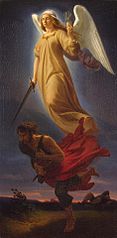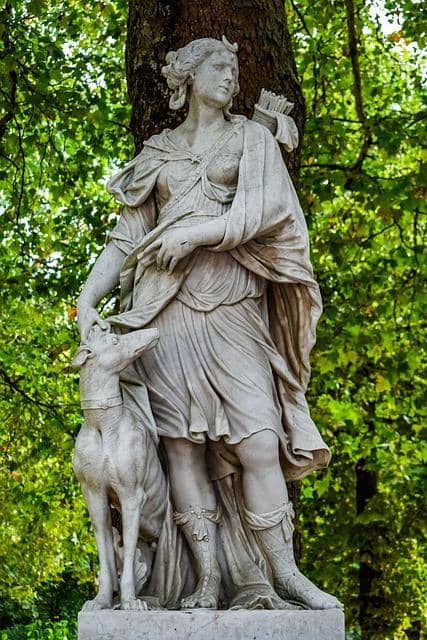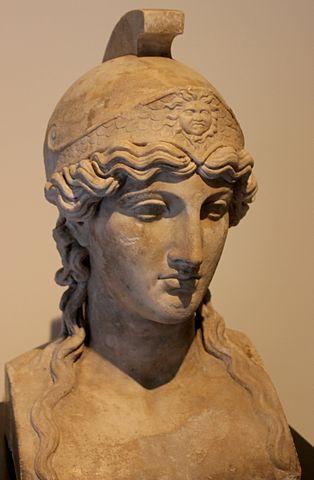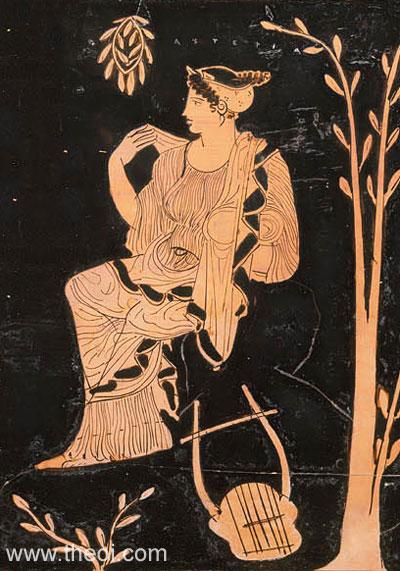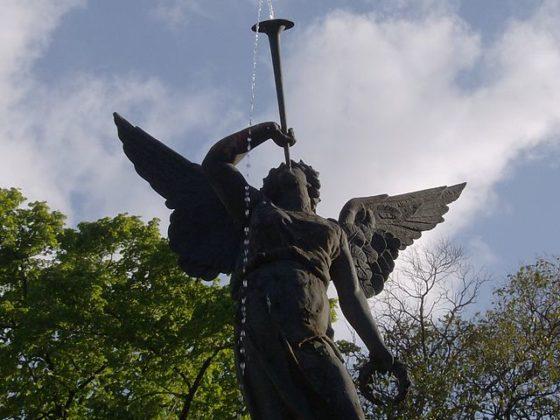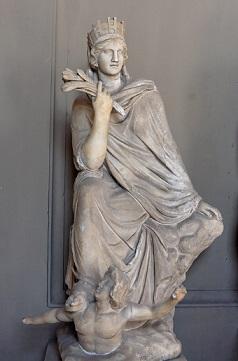Hestia
Also known as the ancient Greek goddess of the hearth, Hestia was the oldest among the first Olympian brothers. His brothers were Zeus, Poseidon, and Hades. It is believed that there were three virgin goddesses in ancient Greek mythology and Hestia was one of them (the other two were Athena and Artemis).
Poseidon and Apollo pursued her relentlessly, as they both wanted to marry her. But she kept the oath she had made to Zeus that she would always remain pure and unblemished and therefore never entered into a marital union. Hestia symbolized the warmth of the house, the burning fire in the hearth.
Most of the ancient Greeks believed that she was the divine representation of the tranquility of a normal domestic life. Despite this, historical and archaeological evidence shows that his pilgrimage never took off. In fact, it is even said that she was removed from the Olympian gods, and her place given to Dionysus.
Hebe
The youngest daughter of Zeus and Hera, Hebe, was considered the godly personification of youth and eternal beauty. It is labeled as the goddess of youth in Greek mythology.
Its name means "youth" in the Greek dialect and many believed that it could even restore youth back to old people.
His role on Mount Olympus was to serve the nectar that made the Olympian gods immortal. Despite being worshiped as a deity who could bless with youth, she was more involved in the daily tasks of Olympus, was Hera's maid and even prepared the royal chariot. Later she married the very popular demigod Hercules and had two sons with him: Alexiares and Aniceto.
Nemesis
Nemesis was the goddess of divine retribution and vengeance, showing her wrath to any human being who displayed arrogance before the gods. She was considered a goddess who had no regrets in her decisions.
Nemesis was a goddess widely represented in Greek tragedies and various other literary works, being the deity who would give what was due to the protagonist. She was often called the "goddess of Rhamnous", an isolated place in Attica. It was believed that she was the daughter of the primordial god Oceanus. However, according to Hesiod, she was the daughter of Erebus and Nyx.
A myth about the goddess Nemesis is the myth of Narcissus, a young man who was very arrogant and despised those who loved him. Nemesis led him to a pool, where he saw his reflection and fell in love with her.
Unable to abandon the reflection of his beloved, he died there. According to another myth, Nemesis created an egg, from which two sets of twins hatched; one set was Helen of Troy and Clytemnestra, and the other was the gods Castor and Pollux.
Artemis
The twin sister of Apollo and the daughter of Zeus and Leto's love, Artemis, is popularly known as the goddess of the hunt, forests and hills, the moon, and archery. It is one of the most respected deities of ancient Greece.
Artemis was not only the goddess of the hunt, but she was also known as the goddess of wild animals, the desert, childbirth, and virginity. In addition, she was the protector of young children and was believed to bring relief from women's illnesses.
In literature and art she was depicted as a huntress carrying a bow and arrow. Artemis was a virgin and attracted the attention and interest of many gods and men. However, only his hunting companion, Orion, won his heart. Orion is believed to have been accidentally killed by Artemis herself or by Gaia, the primordial goddess of Earth.
She was an important goddess in the lives of women, especially when it came to marriage and young children.
Atenea
Athena, was a very important goddess, she was the Greek goddess of wisdom, courage, inspiration, civilization, law and justice, strategic warfare, mathematics, strength, strategy, the arts, trades and the ability.
She is known more specifically for her strategic prowess in warfare and is often portrayed as the companion of heroes and is also the patron goddess of heroic endeavor. Athena was born to Zeus after she experienced a headache.
She did not have a mother, but one of the most cited stories is that Zeus lay with the titanic Metis, the goddess of cunning thought and wisdom, and as he feared that Metis would have a son from him who would be the one to replace him, he swallowed her and then she acquired the attribute of childbirth and gave birth to Athena by her head.
Athena was the female counterpart of Ares. She came out of the head of Zeus, fully adult and dressed in armor and was Zeus's favorite daughter. According to Homer's account in the Iliad, Athena was a fierce and ruthless warrior. In the Odyssey, she was a goddess full of rage and she was ruthless.
Known for protecting civilized life, she was also the Goddess of the City. According to some sources, Athena was praised for her compassion and generosity. Athena was a patron of the arts and crafts, especially when it came to spinning and weaving. Athena embodied wisdom and rational thinking.
She was the guardian of the city of Athens and the Parthenon served as her temple. She is one of three virgin goddesses; The other two were Hestia and Artemis. Athena invented the flute, but she never played it. Zeus trusted her to wield the aegis and its beam. Its most important festival was the Panathenaea, which was held annually in Athens.
Hera
Also known as the goddess of marriage and birth, Hera was the wife of Zeus and that bond made her the queen of all gods. Being the divine representation of marriage, she always showed a special interest in protecting married women and preserving the sacred bond that ignites when two souls are tied in a marital relationship.
She ruled over the heavens and the mortal world long before her marriage to Zeus. Even the mighty Zeus feared him. In her utter anger and anguish over Zeus' never-ending affairs, she would blindly punish others in the name of justice.
Hera was a jealous wife and fought with Zeus frequently over his extramarital infidelities and illegitimate children. For this reason, she was also known to punish unfaithful husbands.
She was the protector of women, presiding over marriages and births. While Hera was worshiped throughout Greece, temples were erected in her honor at Argos and Psalms. The peacock was sacred to her.
Aphrodite
Aphrodite is the Greek goddess of love, beauty and eternal youth. According to Hesiod's theogony, he was born from the foam in the waters of Paphos, on the island of Cyprus. He supposedly rose from the foam when the Titan Cronos killed his father Uranus and threw his genitalia into the sea.
However, according to Homer, Aphrodite may be the daughter of Zeus and Dione. Many gods believed that her beauty was such that their rivalry for her provoked wars between the gods, and because of this Zeus married Aphrodite to Hephaestus, who was no greater threat because of his ugliness and deformity. Despite this marriage, Aphrodite had many lovers.
Asteria
She was a second generation goddess of the Titan gods, daughter of Ceo and Phoebe.
Asteria was the goddess of the night, revered as the dark goddess of necromancy, falling stars, night oracles and prophecies.
After the fall of the Titans, Zeus chased Asteria through the sky, but she escaped him by transforming into a quail and jumping into the sea to become the island of Delos. His sister Leto later gave birth to Apollon on the island.
Demeter
Demeter is the goddess of the harvest and presides over the grains and fertility of the land. She was also the goddess of sacred law, and the cycle of life and death. She was the daughter of Cronos and Rhea.
He had a daughter with the God Zeus; Persephone After Hades kidnapped Persephone, Demeter was grieved. The land was rendered barren by her neglect and the winter season and its manifestations were a reflection of Demeter's emotional state during her absence.
She revealed to man the art of cultivation. Only women attended the thesmophoria, a fertility festival held in honor of Demeter.
Elpis
It is the spirit and personification of hope. She and the other daemons were trapped in a box by Zeus and entrusted to the care of the first woman, Pandora.
When Epimetus opened the box, all the spirits escaped except Elpis (hope), who stayed to comfort humanity. Elpis was depicted as a young woman carrying flowers in her arms. Its opposite was Moros, the spirit of hopelessness and doom.
Gaia
The Greek goddess of the Earth. Known as the great mother of all and is often referred to as "Mother Earth." She created herself out of the primal chaos.
From her fertile womb all life sprouted, and for Mother Earth all living things must return to her after their assigned life span ends.
Nike
The goddess Nike was the winged goddess of victory, both in war and in peaceful competition. When Zeus was gathering allies at the beginning of the war against the Titans, Styx brought his four sons Nike (Victory), Jealousy (Rivalry), Kratos (Strength), and Bia (Strength).
All four became sentinels to the throne of Zeus. At first she was inseparably connected and confused with Pallas Athena. Nike appears wearing a palm, branch, crown, or caduceus of Hermes in works of art.
She is also seen erecting a trophy or recording a victory over a shield. It is frequently seen hovering with its wings spread over the victor in a competition.
Nike gradually came to be recognized as a kind of mediator of success between gods and men, not only in war, but in all kinds of human endeavors.
Peito
Peito was the Greek goddess of persuasion and seduction and had a charming voice. She was a close companion of the goddess Aphrodite. It is generally depicted as a woman fleeing the scene of a rape.
Hesiod quotes Peito and identifies her as one of the three thousand daughters of Oceans and Tethys. Although this goddess did not wield much power beyond her small sphere of influence, she is nevertheless an important figure in myth, legend, and religion.
Rea
Rhea was the goddess of nature, daughter of the goddess of the Earth Gaia and Uranus, god of the sky, and was known as "the mother of the gods." Rhea was one of the titans, she was the sister and wife of Cronos, also a titan.
She was responsible for how things flow in the kingdom of Cronos (her name means "what flows"). Rea and Cronos had six children; Hestia, Hades, Demeter, Poseidon, Hera, and Zeus.
Cronos, fearful of being overthrown by his sons, decided to swallow them all. However, he was tricked by Rhea, who managed to save Zeus from his father. When Zeus grew up, he forced his father to give back his brothers and eventually overthrew him.
Although Rhea was considered the "mother of gods", she did not have a strong cult or many followers. He had a temple in Crete, the place where he hid Zeus to save him from his father.
In art, it began to appear in the fourth century BC. However, it was often depicted with characteristics similar to those of the goddess Cybele, thus making the two goddesses indistinguishable.
Selene
Selene was the daughter of the Titans Hyperón and Teia. He had two brothers, Helios and Eos. She was the goddess of the moon, who drove each night through the skies. She was linked to Artemis, as well as Hecate; all three were considered lunar goddesses.
He had an affair with a mortal named Endymion, whom Zeus had granted the choice to know when he was going to die. Endymion chose to fall into an eternal sleep to remain eternal and immortal.
According to other sources, Selene was one of Zeus's lovers and they had several children; Pandea, which is all shiny; Ersa, the dew; Nemea, a nymph; and Dionysus, although this may be a confusion due to the resemblance between Selene and Semele.
Feme
The goddess of fame, gossip and rumor. Feme is the daughter of Gaia, and she carried the good and the bad news, since it was said that the rumors originated in the environment of the gods. She was called the messenger of Zeus.
Terpsichore
Daughter of Zeus, the goddess Terpsichore was one of the nine muses. She was the goddess of music, song, and dance. In the classical era, when the muses were assigned to specific literary and artistic spheres, Terpsichore was named the muse of song and choral dance, and represented with a lyre and plectrum.
Tyche
Goddess of prosperity and fortune. She was one of the goddesses of destiny and was therefore linked to the three destinies in ancient Greek mythology. Tique was often worshiped in cities as the guardian of good luck and prosperity.
If at some point her behavior was considered arrogant, she was severely admonished by the goddess Nemesis.
Nix
Nix represents night, beauty and power. She represents beauty because she was incredibly beautiful and portrayed as one of the most beautiful goddesses on the face of the earth. And power is one of her values, because both gods and men feared her very much.
Metis
Greek goddess of wisdom. The goddess Metis was born to the pair of titans Ocean and Thetis, probably at a similar time to Zeus and his brothers. This kinship would make Metis an Oceanid, one of the 3,000 daughters of Ocean.
The oceans were normally classified as nymphs, minor figures in Greek mythology associated with lakes, springs, and wells. Metis however, was a much more important figure, and would be named after the Greek goddess of wisdom.


